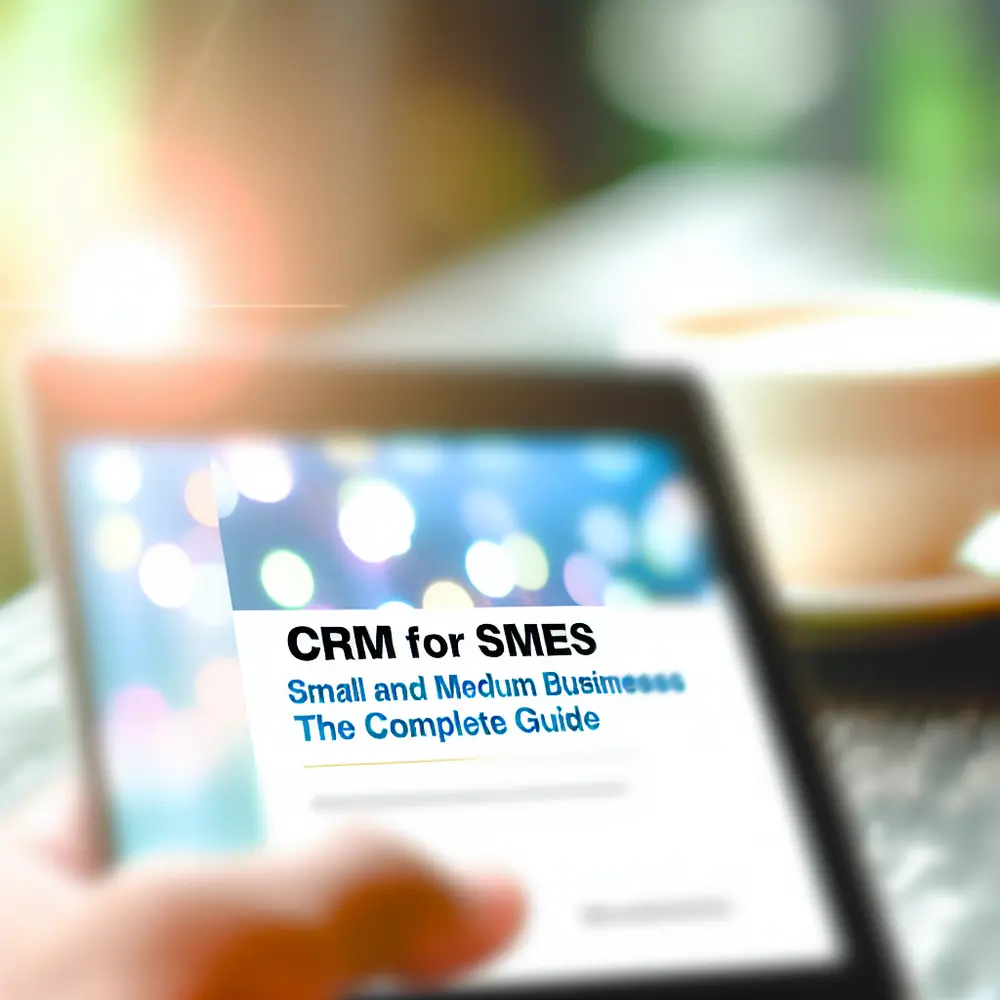In today’s fast-paced business environment, the ability to manage customer relationships effectively has become paramount, especially for small and medium enterprises (SMEs). A well-integrated Customer Relationship Management (CRM) system can serve as a powerful tool in this regard, offering businesses the strategies and resources needed to enhance their interactions with customers. But why exactly should SMEs invest in CRM? This article will delve into the myriad benefits of CRM systems, from improved customer satisfaction to streamlined operations, providing a comprehensive understanding of their impact.
As we explore the significance of CRM solutions, it’s important to note how these systems not only improve communication and data management but also enable businesses to thrive in a highly competitive marketplace. Implementing these solutions can transform the way SMEs operate by fostering deeper connections with customers and refining sales strategies. Moreover, understanding the core features and trends in CRM technology will empower businesses to select the best system suited to their specific needs.
With a commitment to continual growth and customer satisfaction, SMEs can leverage CRM systems not only to improve their day-to-day operations but also to set the foundation for long-term success. Prepare to discover how effectively integrating CRM into your business strategy can foster customer loyalty, increase sales, and enhance overall operational efficiency.
The Importance of CRM for SMEs
CRM, ou Customer Relationship Management, é uma estratégia essencial para pequenas e médias empresas (PMEs) que buscam otimizar suas interações com clientes atuais e potenciais. A implementação de um sistema CRM permite que as empresas organizem, automatizem e sincronizem todos os processos de negócios relacionados a clientes, incluindo vendas, marketing e atendimento ao cliente. Ao centralizar informações em uma única plataforma, as PMEs conseguem ter uma visão completa e detalhada de cada cliente, facilitando a personalização do atendimento e o aumento da satisfação do cliente.
A importância do CRM para as PMEs não pode ser subestimada. Ele não apenas melhora a gestão dos relacionamentos com os clientes, mas também oferece ferramentas valiosas que ajudam a identificar tendências, analisar comportamentos e prever necessidades futuras. Essas informações são cruciais para tomadas de decisões estratégicas, permitindo que as empresas ajustem suas ofertas e abordagens de vendas. Com um CRM eficaz, as pequenas e médias empresas podem competir de forma mais eficiente contra grandes corporações, utilizando dados para segmentar o mercado e personalizar as comunicações.
Além disso, a adoção de soluções de CRM facilita a automação de tarefas repetitivas, permitindo que os colaboradores se concentrem em atividades que realmente agregam valor, como o fechamento de vendas e o engajamento com os clientes. Isso não só aumenta a produtividade das equipes, mas também proporciona uma experiência mais fluida e eficiente para o cliente. O resultado é um ciclo virtuoso onde clientes satisfeitos representam não apenas vendas recorrentes, mas também um aumento na recomendação e na reputação da marca.
Por fim, ao considerar as opções de CRM disponíveis, as PMEs devem avaliar as soluções que melhor se adaptam às suas necessidades específicas. Muitas plataformas CRM são projetadas com funcionalidades escaláveis, permitindo que as empresas iniciassem com um conjunto básico de ferramentas que, à medida que crescem, podem ser expandidas para incluir soluções mais avançadas. Com um entendimento claro do que é CRM e por que ele é vital, os proprietários de negócios, gerentes de vendas e profissionais de atendimento estão mais bem preparados para adotar essa tecnologia, garantindo um futuro mais promissor para suas empresas.
Effective Features of CRM Systems
Effective CRM solutions for small and medium enterprises (SMEs) are built upon several key features that significantly enhance engagement, streamline processes, and support growth. Understanding these features can help business owners, sales managers, and customer service professionals select the right CRM system to address their unique needs.
One of the most critical features of a successful CRM is its user-friendly interface. A system that is simple to navigate and understand ensures that all team members can utilize it effectively, minimizing the learning curve and promoting widespread adoption. This ease of use is especially vital for SMEs, where team members may wear multiple hats and lack extensive training in sophisticated software systems. A well-designed CRM allows users to access customer data, manage interactions, and utilize reporting tools with minimal effort, enhancing their overall productivity.
Another essential feature is automation capabilities. Automation in CRM can save time and increase efficiency by streamlining routine tasks such as data entry, follow-up reminders, and workflow management. For SMEs, this means that staff can focus on higher-value activities, such as building relationships or closing sales, rather than getting bogged down by repetitive tasks. Moreover, automation can enhance accuracy by reducing human error and ensuring that important tasks are not overlooked. Features such as automated email campaigns and customer follow-ups can help maintain engagement with leads and existing customers without additional manual effort.
Integration with other tools and platforms is also a significant advantage of effective CRM solutions. SMEs often rely on multiple software applications for various functions, including sales, marketing, and customer support. A CRM that can seamlessly integrate with these tools—such as email marketing software, accounting systems, and social media platforms—facilitates the sharing of data across departments. This holistic view of the customer journey enables better decision-making and creates a cohesive experience for clients, ultimately driving customer satisfaction and loyalty.
Choosing the Right CRM
Choosing the right CRM (Customer Relationship Management) system is crucial for small and medium businesses (SMEs) looking to enhance customer relationships and streamline operations. With countless options available, selecting the most appropriate CRM for your needs can be overwhelming. This step-by-step guide aims to simplify the process by focusing on key considerations, ensuring that you find a solution that aligns with your business objectives.
The first step in choosing the right CRM is evaluating your business requirements. Identify the specific pain points that you want to address, such as improving lead management, automating customer communications, or integrating with existing tools. Engage your team in discussions to gain insights into their needs and preferences, as they will be the primary users of the system. Clearly mapping out your objectives will lay the groundwork for assessing available CRM options effectively.
Next, consider the features offered by various CRM solutions. While SMEs may initially gravitate toward cost-effective options, it is essential to evaluate the functionalities that can drive growth. Look for features such as pipeline management, reporting and analytics, email integration, and mobile accessibility. A comprehensive CRM should also offer automation capabilities to enhance efficiency and save your team valuable time. Ensure that the selected solution can scale alongside your business, allowing you to add features or users without significant disruptions.
After narrowing down your options, research the customer support and training offered by CRM providers. A user-friendly interface is important, but ongoing support is equally vital to maximize your investment. Determine whether the vendor offers tutorials, webinars, or dedicated account managers to assist with implementation and troubleshooting. Investing in robust support services can significantly enhance user adoption and help your team to become proficient in using the CRM.
Integrating CRM with Existing Systems
Integrating Customer Relationship Management (CRM) systems with existing business processes is crucial for small and medium-sized enterprises (SMEs) looking to enhance their efficiency and customer engagement. A seamless integration allows businesses to synchronize data across various platforms, improving data accuracy and minimizing manual entry errors. By adopting a CRM solution that is compatible with current systems—such as ERP, email marketing tools, and accounting software—business owners can leverage their existing technology infrastructure while gaining additional functionalities that drive productivity.
One of the key benefits of integrating CRM with existing business systems is the creation of a unified view of customer interactions and behaviors. This consolidated view empowers sales managers and customer service professionals to access vital information instantly, enabling them to tailor their communications effectively. For instance, when a customer reaches out, the support team can quickly retrieve the customer’s purchasing history, past interactions, and preferences. This level of context not only enhances the customer experience but also fosters deeper relationships, leading to increased customer loyalty and retention.
Furthermore, automation plays a pivotal role in the integration process. By automating routine tasks—such as data entry, follow-ups, and reporting—businesses can allocate their resources more efficiently. The use of workflows within an integrated CRM system reduces the chances of human error and ensures that no lead or customer query goes unnoticed. For SMEs, this is particularly essential, as they often operate with limited staff and resources. Implementing automated processes allows teams to focus more on strategic initiatives rather than on mundane operational tasks.
To ensure successful integration, it’s vital for SMEs to evaluate potential CRM solutions carefully. Business owners should consider factors such as ease of use, scalability, and the ability to customize the CRM to meet their specific needs. Additionally, training and support resources should be prioritized to help staff adapt to the new system efficiently. Using a guideline or tutorial can be advantageous in helping teams understand and utilize the full capabilities of their CRM, ultimately transforming the way they manage customer relationships and drive business growth. Integrating CRM into existing business systems is not just a technological upgrade; it’s a strategic move that positions SMEs for long-term success in an increasingly competitive market.
Best Practices for Implementing CRM
Implementing a Customer Relationship Management (CRM) system is a strategic move that can elevate small and medium enterprises (SMEs) to new heights. Businesses must approach the implementation process thoughtfully, ensuring alignment with their specific needs and goals. One of the first steps is to conduct a comprehensive analysis of current processes—mapping out customer interactions, identifying pain points, and understanding how data is currently managed. This analysis helps in choosing the right CRM solution that not only integrates smoothly but also enhances workflows.
Customization is a vital best practice during CRM implementation. The chosen platform should be tailored to cater to the unique requirements of the business. This includes configuring fields, setting up workflows, and integrating with other tools used within the organization. Many CRM solutions offer customization options that allow businesses to create a system that closely reflects their operational processes. Engaging stakeholders—from sales teams to customer service representatives—during this phase ensures that the CRM meets the end-users’ needs, promoting higher adoption rates and better overall satisfaction.
Training and support are critical components of a successful CRM implementation. Providing comprehensive training sessions for employees can mitigate resistance to change and foster a deeper understanding of the system’s capabilities. Businesses should consider investing in resources such as training manuals, video tutorials, and ongoing support to assist users in navigating the new software. Encouraging a culture of learning and adaptability within the team can significantly enhance engagement and utilization of the CRM, ultimately yielding better data management and customer insights.
Finally, monitoring and evaluating the CRM’s performance post-implementation is essential for sustained success. Businesses should set clear KPIs and regularly assess how well the CRM supports their objectives, including customer satisfaction, response times, and sales conversion rates. Feedback from users should be sought to identify any areas requiring improvement or additional features that could be useful. Continuous improvement not only optimizes the use of the CRM but also ensures that it evolves alongside the business’s changing needs, making it a valuable asset in driving growth and efficiency.
Measuring the Success of Your CRM
Measuring the success of a Customer Relationship Management (CRM) system is essential for small and medium businesses (SMEs) looking to optimize their performance and enhance customer satisfaction. A comprehensive evaluation of key metrics and Key Performance Indicators (KPIs) can provide invaluable insights into how effectively a CRM solution is meeting the organization’s objectives. By regularly assessing these indicators, business owners, sales managers, and customer service professionals can make informed decisions and adjustments that will lead to improved operational efficiency.
One of the primary metrics to consider when measuring CRM success is customer retention rate. This figure represents the percentage of customers who continue to do business with a company over a specified timeframe. High customer retention not only indicates that a business is providing satisfactory service but also signifies a stronger customer loyalty base. By tracking this metric, businesses can identify trends and take proactive steps to address any issues that may arise, ultimately enhancing customer satisfaction and increasing lifetime value.
Another critical KPI to track is the sales conversion rate, which measures the percentage of leads that are converted into paying customers. An effective CRM should streamline the sales process, allowing teams to nurture leads more efficiently. By analyzing conversion rates, SMEs can pinpoint areas within their sales funnel that may need improvement or additional focus, such as lead qualification processes or follow-up strategies. This metric enables businesses to gauge the effectiveness of their sales strategies and make data-driven adjustments to enhance profitability.
In addition to retention and conversion rates, monitoring customer satisfaction scores is vital for assessing CRM effectiveness. Surveys and feedback mechanisms can provide direct insights into how customers perceive their interactions with the company. By analyzing this data, SMEs can identify strengths and weaknesses within their customer service approach, allowing them to tailor their strategies to better meet client expectations. Ultimately, a strong focus on customer satisfaction can lead to improved customer loyalty, more referrals, and increased revenue.
Real-life Examples of CRM Success
Real-life case studies illustrate the transformative power of CRM systems for small and medium enterprises (SMEs). Many SMEs, initially hesitant about adopting technology, have successfully leveraged CRM solutions to streamline their operations, enhance customer relationships, and significantly boost their sales performance. In this section, we will explore some noteworthy examples of SMEs that have integrated CRM into their workflows, showcasing the diverse applications and benefits of these systems.
One compelling case is that of XYZ Ltd., a small manufacturing firm that faced challenges in managing customer interactions and tracking sales inquiries. By implementing a CRM solution, the company was able to centralize customer data and automate its sales processes. As a result, they reported a 40% increase in lead conversions within six months. The CRM provided sales managers with insights into customer preferences, enabling them to tailor their approaches and improve follow-up strategies. This enhanced engagement not only boosted sales but also led to higher customer satisfaction rates.
Another inspiring example is the retail SME, ABC Boutique, which struggled with inventory management and customer retention. After adopting a CRM system, ABC Boutique integrated their customer data with inventory insights, allowing them to track purchasing behaviors and preferences. Utilizing this information, they launched personalized marketing campaigns that resulted in a 30% increase in repeat purchases. This case highlights how CRM can help SMEs not only streamline their operations but also engage more effectively with their customers, ultimately leading to sustainable business growth.
In the service sector, DEF Consulting, a small firm focused on marketing services, implemented a CRM system to enhance its client relationship management. With a clearer view of project timelines, client communications, and follow-up schedules, DEF Consulting was able to increase project delivery efficiency by 25%. The CRM’s reporting features provided insights into client needs and satisfaction levels, allowing the team to refine their service offerings continually. The positive impact on client relationships has been significant, contributing to a steady rise in referrals and new business opportunities.
Future Trends in CRM for SMEs
As small and medium enterprises (SMEs) are rapidly embracing CRM systems as essential tools to drive growth and improve customer relationships. As we look to the future, several trends are emerging that will significantly impact the CRM landscape for SMEs. Understanding these trends will be crucial for business owners, sales managers, and customer service professionals aiming to leverage CRM solutions effectively.
One of the most significant trends in CRM for SMEs is the increasing use of artificial intelligence (AI) and machine learning. Essas tecnologias permitem que os sistemas CRM ofereçam análises avançadas, automatizem tarefas rotineiras e proporcionem experiências personalizadas para os clientes. A inteligência artificial pode analisar grandes volumes de dados para gerar insights que ajudam as empresas a entender melhor o comportamento do cliente e prever compras futuras. Essa capacidade não apenas simplifica as operações, mas também melhora a tomada de decisões, levando a estratégias de marketing mais eficazes e um desempenho de vendas aprimorado.
Outra tendência é a crescente integração do CRM com outros sistemas e aplicativos de negócios. As PMEs estão reconhecendo a importância de ter uma plataforma unificada onde todas as interações e dados do cliente possam ser consolidados. Essa integração significa que as equipes de vendas, marketing e atendimento ao cliente podem acessar informações em tempo real, melhorando a colaboração e a eficiência. Integrações aprimoradas com soluções empresariais, como sistemas ERP, também estão ajudando as PMEs a fornecer uma experiência contínua desde o engajamento do cliente até a entrega, fortalecendo, em última análise, a lealdade e a retenção do cliente.
Além disso, há uma mudança notável em direção a soluções de CRM baseadas em nuvem, tornando-as mais acessíveis para as PMEs. A infraestrutura em nuvem oferece escalabilidade e flexibilidade, permitindo que as empresas adaptem suas capacidades de CRM às necessidades crescentes dos clientes sem investimentos substanciais em infraestrutura. Com recursos como acesso móvel e ferramentas de colaboração remota se tornando padrão, as PMEs podem gerenciar relacionamentos com clientes de forma eficiente, mesmo quando as equipes estão distribuídas em diferentes locais.
Por fim, o foco na centralidade do cliente está moldando os desenvolvimentos futuros do CRM. As empresas estão cada vez mais buscando sistemas CRM não apenas como ferramentas para rastrear vendas, mas como plataformas para fomentar relacionamentos mais profundos com os clientes. Essa mudança está levando a novos recursos que priorizam o engajamento do cliente, como recursos de comunicação multicanal, funções de CRM social e loops de feedback de clientes. Ao priorizar essas iniciativas centradas no cliente, as PMEs podem garantir que permaneçam competitivas em um mercado que favorece serviços personalizados e responsivos.
Conclusion
As SMEs increasingly recognize the importance of customer relationship management (CRM) systems, the path forward involves strategically aligning these solutions with their unique needs and growth objectives. Implementing a CRM can lead to improved communication with customers, enhanced data analytics, and streamlined processes. This journey begins with selecting the right CRM that fits the size and complexity of the business while offering the necessary functionality to drive engagement and sales effectively.
One of the key advantages of adopting a CRM system for your SME is the ability to centralize customer information. This consolidation not only enhances the efficiency of sales and customer service teams, but also allows for better customer insights. By utilizing CRM software, businesses can automate routine tasks, such as follow-ups and reporting, freeing up valuable time for employees to focus on building relationships and closing deals. In the competitive landscape of small and medium enterprises, such efficiencies can translate to significant cost savings and revenue growth.
Moreover, the integration of CRM with other enterprise solutions is vital for maximizing its potential. Many modern CRMs offer APIs and functionalities that can seamlessly connect with marketing tools, e-commerce platforms, and accounting software. This interconnectedness ensures that SMEs are leveraging all resources effectively, enabling them to create a holistic view of their customer interactions. Furthermore, continuous training and support for your team in using CRM systems will cultivate a culture of data-driven decision-making, crucial for adapting to market changes and consumer preferences.
As we conclude this guide, it’s essential to emphasize the transformative potential of CRM for SMEs. It is not merely a tool for managing relationships; rather, it serves as a strategic partner that empowers businesses to understand their customers deeply, respond to their needs promptly, and ultimately drive growth. By approaching CRM implementation and utilization as an ongoing journey, rather than a one-time task, SMEs can position themselves for sustained success and competitive advantage, ensuring they are not just surviving but thriving in today’s dynamic business environment.









